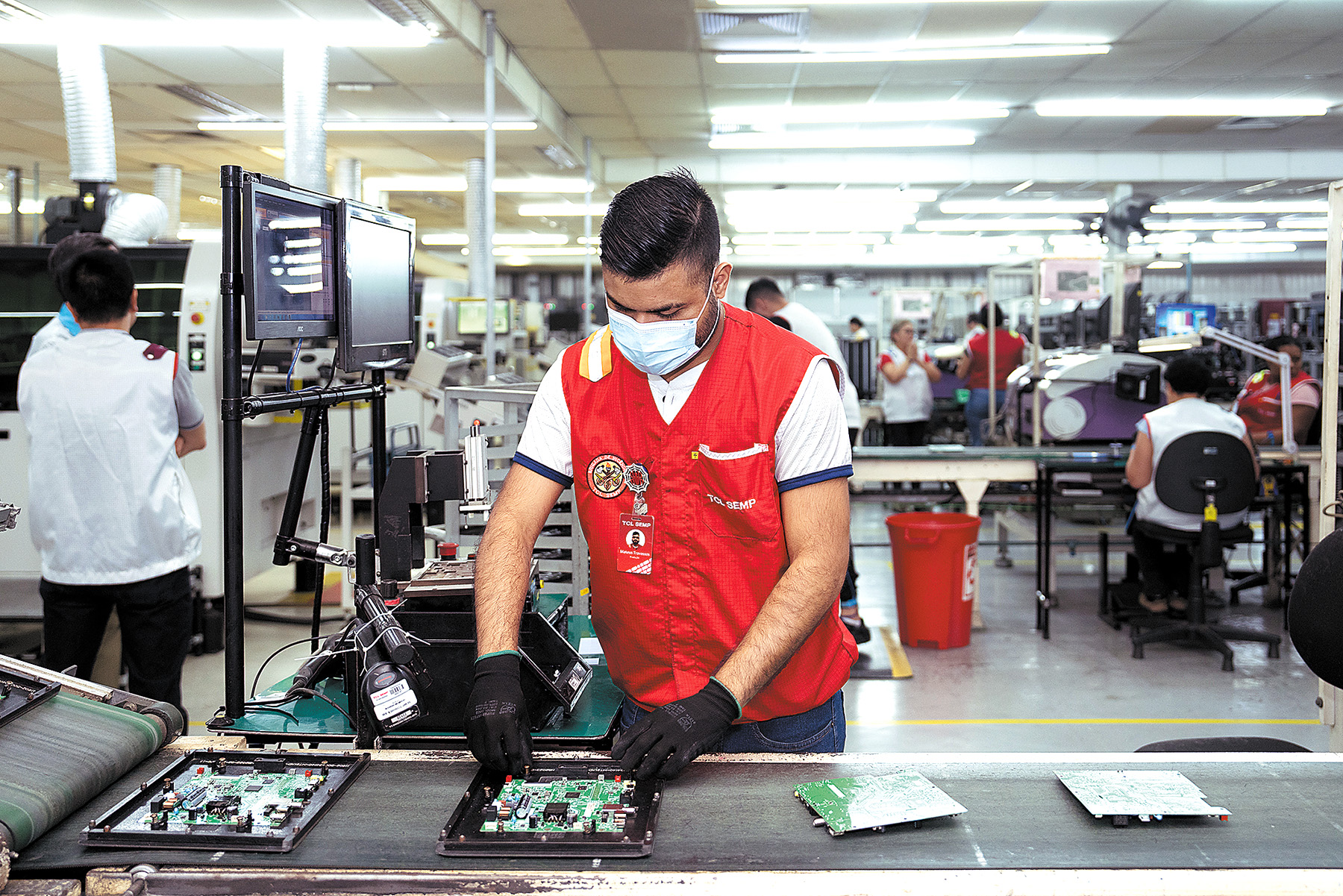Innovative Chinese firms focus on high-end products in foreign ventures, showcase global competitiveness

For decades, Chinese companies have distinguished themselves abroad by undertaking large-scale construction and energy projects. Now, however, as many parts of the world enter a new phase of development, the firms are tweaking their strategies to better align with the evolving environment. The focus is on generating revenue through higher value business ventures that are more suited to the changing scene.
For instance, just as multinational automotive manufacturers such as General Motors from the United States and Stellantis NV from the Netherlands recently revealed plans to upgrade their production facilities in Brazil and launch a hybrid vehicle in that country later this year,
Chinese automaker BYD initiated the construction of its new manufacturing facilities in the Brazilian state of Bahia in early March.
BYD’s Brazil unit will produce electric and hybrid vehicles, electric buses and trucks, and battery products, for both local and global markets.
According to an announcement from the local government, BYD’s automobile manufacturing plant is anticipated to begin operations between late this year and early 2025. The initial production capacity is set at 150,000 electric and hybrid vehicles per year, with potential to expand to 300,000 units in the future.
Recognizing the need to directly compete with both domestic and international competitors in foreign markets, Great Wall Motor Co, another Chinese automaker, started upgrading its production lines at its factory in the Brazilian state of Sao Paulo last year. The company plans to start manufacturing electric vehicles later this year.
Even though ports, bridges, railway lines, mining and energy-related facilities continue to bear testimony to Chinese firms’ capabilities, a growing number of Chinese companies are now expanding their ventures into high-tech manufacturing, innovation-driven businesses, clean energy, logistics, cross-border e-commerce and service sectors abroad, said Lyu Yue, a professor at the Academy of China Open Economy Studies, part of the University of International Business and Economics in Beijing.
China’s nonfinancial outbound direct investment (ODI) grew by nearly 17 percent year-on-year to 916.99 billion yuan ($127.37 billion) in 2023, data from the Ministry of Commerce showed.
Nonfinancial ODI in countries and regions participating in the Belt and Road Initiative (BRI) came in at 224.09 billion yuan last year, soaring more than 28 percent year-on-year.
China’s ongoing efforts to expand its institutional opening-up and seal high-standard economic and free trade deals, coupled with the rapid growth of its tech-intensive green product industries, are expected to drive its companies to strategically invest in new plants, service and innovation facilities in overseas markets, said Zhao Ping, dean of the Beijing-based Academy of China Council for the Promotion of International Trade.
“The ongoing restructuring of the global supply chain presents opportunities for Chinese companies to align their strengths with evolving market demands. Chinese firms are demonstrating strong competitiveness in manufacturing sectors like new energy vehicles, lithium-ion batteries and photovoltaic products, resulting in greater acceptance of their involvement by numerous countries,” said Zhao, predicting that Chinese ODI will grow steadily this year.

Despite challenges like global economic uncertainties, geopolitical tensions and evolving international economic and trade regulations, “go-global” will continue to be a key growth strategy of corporate China, said Eddy Chan, senior vice-president of FedEx Express and president of FedEx China.
“Many Chinese companies are increasingly focusing their investments and resources on manufacturing operations in Southeast Asia. This shift has resulted in growing demand for customized services to ensure the smooth operation of their supply chains within the region,” said Chan.
The US courier service provider announced in mid-March that it had completed significant upgrades to its gateway facility in Shenzhen, Guangdong province. The facility now boasts an intelligent management system called e-warehouse.
Chinese companies’ dynamic investment approach has led to significant global advances in areas like trade in services, new foreign trade formats and digital and green growth in recent years.
Trade in services refers to purchase and sale of services. According to the World Trade Organization’s definition, trade in services covers 12 major sectors. These include commerce, communication, construction and related engineering, finance, entertainment, culture, sports, tourism, education and environment.
“These moves have helped drive economies and job markets in many countries, especially those in Southeast Asia, South America, the Middle East and Europe,” said Johnny Chou, chairman and CEO of BEST Inc. The Hangzhou, Zhejiang province-based logistics services provider opened its largest sorting center by facility size in Southeast Asia in Kuala Lumpur, Malaysia, in January.
EVE Energy Co, a battery manufacturer based in Huizhou, Guangdong province, is another example. The Chinese company is constructing a battery plant in Debrecen, Hungary, to supply batteries to BMW Group’s Debrecen factory. With an investment of 1 billion euros ($1.08 billion), the Chinese company will help generate over 1,000 new jobs for the local community.
Liu Jincheng, the company’s chairman, said the factory is scheduled to be completed and put into operation in 2026.
“In terms of internationalization trends, Chinese battery companies have advantages in both materials and equipment. We are able to serve global customers with an entire industrial chain,” he said.
With advantageous geographical location and mature industrial infrastructure, Hungary remains a top destination for Chinese investment in Central and East Europe, covering a range of areas, including manufacturing, chemicals, finance, telecommunications, automobiles and logistics, according to information released by the economic and commercial office of the Chinese Embassy in Budapest.
As Chinese technology has advanced rapidly, “Made in China” and “globalization” have emerged as the defining features of the Chinese business culture, said Lin Meng, director of the Modern Supply Chain Research Institute at the Beijing-based Chinese Academy of International Trade and Economic Cooperation.
Amid greater efforts by many Middle Eastern countries to utilize the digital economy for sustainable growth, Terminus Group, a Beijing-based artificial intelligence services provider, launched its international headquarters in Dubai, the United Arab Emirates, in late February, to capture a larger market share in the region.
The new headquarters will facilitate Terminus’ projects and business expansion initiatives in the UAE, Saudi Arabia, Qatar, Oman and other countries in the region. It will also support the group’s operations in Singapore and Australia, as well as many countries participating in the BRI.
The Chinese company will also set up an artificial intelligence (AI) laboratory in the new facility, focusing on cutting-edge exploration in the field of AI and the development of targeted solutions for the international market.
Victor Ai, CEO of Terminus Group, said that as many Middle Eastern countries strive to advance in eco-friendly energy, manufacturing and smart city initiatives, the company aims to fully capitalize on its AIoT (artificial intelligence of things) strengths to engage in related projects in these markets.
According to a report published by UBS Group, the Switzerland-based multinational investment bank, the size of the digital economy in the Middle East is projected to grow from $180 billion in 2022 to $780 billion by 2030, with an average compound annual growth rate of 20 percent. This will make it one of the fastest-growing regions in the global digital economy over the coming years.
Chinese companies, especially those from the private sector, are embarking on a new phase of global expansion, with China’s technology and brands making significant inroads overseas and exploring new opportunities for growth, said Lu Feng, a professor of economics at Peking University’s National School of Development.
Guo Tingting, vice-minister of commerce, said China’s cooperation with other countries will continue to expand, particularly in the green economy, digital economy and blue economy, in the coming years.
The trend of China’s outbound investment growth will likely continue this year. The nation saw its nonfinancial ODI surge 10 percent year-on-year to 149.64 billion yuan in the first two months, according to the Ministry of Commerce.
To create more favorable conditions for boosting China’s foreign trade, attracting foreign investment and enhancing Chinese companies’ global competitive power, the ministry said in late March that the country will use a variety of channels to engage in multilevel communication and exchanges with all relevant parties.
The initiative will help quicken China’s accession to the Comprehensive and Progressive Agreement for Trans-Pacific Partnership, a multilateral free trade agreement with high-standard economic and trade rules.


